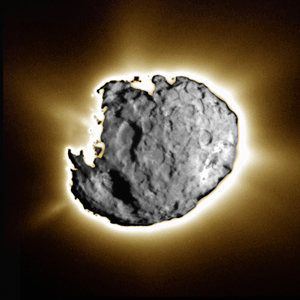 The
pace of meteorite recoveries continued unabated in 2003, with 1,898 new meteorites
reported. At the same time, a flotilla of remote-sensing missions to Mars (Mars
Global Surveyor, Mars Odyssey, Mars Exploration Rover Mission, Mars Express),
as well as sample-return missions to an asteroid (Hayabusa), a comet (Stardust)
and to collect solar wind (Genesis), remained active. Research in meteoritics
over the last year underscores the connection between extraterrestrial materials
recovered on Earth and the spacecraft missions that continue our exploration
of the Solar System.
The
pace of meteorite recoveries continued unabated in 2003, with 1,898 new meteorites
reported. At the same time, a flotilla of remote-sensing missions to Mars (Mars
Global Surveyor, Mars Odyssey, Mars Exploration Rover Mission, Mars Express),
as well as sample-return missions to an asteroid (Hayabusa), a comet (Stardust)
and to collect solar wind (Genesis), remained active. Research in meteoritics
over the last year underscores the connection between extraterrestrial materials
recovered on Earth and the spacecraft missions that continue our exploration
of the Solar System.This composite image was taken by the navigation camera during the close approach phase of Stardust's Jan. 2, 2004 flyby of comet Wild 2, about five kilometers in diameter. To create this image, researchers overlaid a short-exposure image showing surface detail on a long-exposure image taken just 10 seconds later showing jets. Together, the images show an intensely active surface, with several large depressed regions, as well as jetting dust and gas streams, which leave a trail millions of kilometers long. Photo courtesy of NASA/JPL.
In April 2003, Scott Messenger, now at NASA's Johnson Space Center, and colleagues at Washington University in St. Louis provided the first positive identification of silicates that formed outside our Solar System, confirming an idea first suggested by John Bradley, now at Lawrence Livermore National Laboratory. Found in interplanetary dust particles from short-period comets, these silicates contain anomalous oxygen isotopic compositions that provide clues to the stellar environments in which they formed. Their discovery heightened the anticipation for the return of samples collected from comet Wild 2 by the Stardust mission on Jan. 2, 2004.
Two of the smallest groups of meteorites received the greatest attention in the past year. The bencubbinites, with only six members, contain metal and silicate chondrules an order of magnitude larger than most, reaching a centimeter in diameter, and with metal comprising up to 60 percent volume. Previous workers argued for a nebular origin, perhaps even as nebular condensates, but Alan Rubin of the University of California, Los Angeles, and co-workers suggest formation by condensation in an impact-generated plume.
The olivine-rich brachinites, a group of differentiated meteorites with only eight members, have also been the subject of debate, with competing theories of formation by limited partial melting or crystallization from a magma. David Mittlefehldt of Johnson Space Center and colleagues have marshaled the evidence for an origin as igneous cumulates, suggesting that olivine-rich lithologies could be common on differentiated asteroids. Current missions to collect the impact-altered regolith of 25143 asteroid Itokawa by the Japanese Hayabusa mission and to remotely study the differentiated asteroid Vesta (by the planned DAWN mission) might provide insights into the processes that formed these meteorites.
Martian meteorites continue to hold special significance as our only samples of the red planet. Jeff Taylor of the University of Hawaii and colleagues on the Mars Odyssey gamma-ray spectrometer experiment suggested that these meteorites may be atypical of the Mars crust, based on differences in potassium and thorium abundances between martian meteorites and the crust of Mars. Victoria Hamilton, also of the University of Hawaii, and colleagues reached a similar conclusion by using Mars Global Surveyor Thermal Emission Spectrometer data. These authors were unable to find any areas on Mars similar to the abundant basaltic shergottites, although they did discover areas that could be the original sites of olivine-, orthopyroxene- and clinopyroxene-rich rocks (now sampled as meteorites).
It seems that the linkages between meteorites and the planets, asteroids and comets from which they originate will only strengthen in the next few years, as samples are returned from these objects and spacecraft continue to explore our solar system.
Back to index

